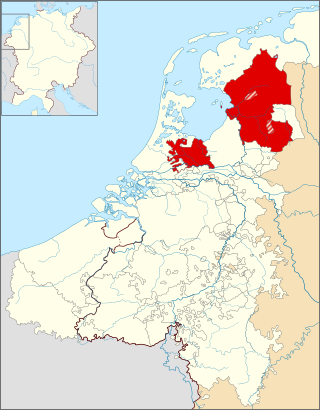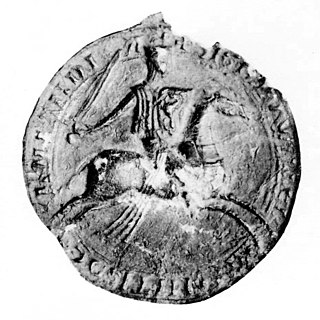
The Bishopric of Utrecht was an ecclesiastical principality of the Holy Roman Empire in the Low Countries, in the present-day Netherlands. From 1024 to 1528, as one of the prince-bishoprics of the Holy Roman Empire, it was ruled by the bishops of Utrecht. The Prince-Bishopric of Utrecht must not be confused with the Diocese of Utrecht, which extended beyond the Prince-Bishopric and over which the bishop exercised spiritual authority.

The County of Holland was a state of the Holy Roman Empire and from 1433 part of the Burgundian Netherlands, from 1482 part of the Habsburg Netherlands and from 1581 onward the leading province of the Dutch Republic, of which it remained a part until the Batavian Revolution in 1795. The territory of the County of Holland corresponds roughly with the current provinces of North Holland and South Holland in the Netherlands.

William I was count of Holland from 1203 to 1222. He was the younger son of Floris III and Ada of Huntingdon.
Dirk VI was Count of Holland between 1121 and 1157, at first, during his minority, under the regency of his mother Petronilla. He was the son of Count Floris II. After his death he was succeeded by his eldest son Floris III. He married Sofie of Salm, Countess of Rheineck and Bentheim. She was heiress of Bentheim, which she ruled together with her husband and which was inherited by the couple's second son Otto after his parents' death.
Dirk VII was the count of Holland from 1190 to 1203. He was the elder son of Floris III and Ada of Huntingdon.
Dirk IV was Count of Holland from 1039 to 1049. Dirk's date of birth is unknown but it was probably ca. 1030 or shortly before, he was described as "adolescent" at the time of his death. His base of operations was the stronghold his father built at Vlaardingen. Contemporary chroniclers referred to him as "Theodericus de Phlardirtinga" (Vlaardingen) and as margrave thereof. The exact extent of his domain is not known, but at one time or another it stretched north to at least Rijnsburg and east to roughly Aalburg.

Rudolf van Diepholt or Rudolf of Diepholz was a bishop of Utrecht from 1423 to 1455 and bishop of Osnabrück from 1454 to 1455.

Guy van Avennes was Bishop of Utrecht from 1301 to 1317.
John of Arkel or Jan van Arkel was a Bishop of Utrecht from 1342 to 1364 and Prince-Bishop of Liège from 1364 to 1378.
Dirk van Holland was bishop of Utrecht in 1197.
Jacob van Oudshoorn was bishop of Utrecht in 1322.
Zweder van Culemborg was bishop of Utrecht during the Utrecht Schism.
Sophia of Rheineck, also known as Sophie of Salm, Countess of Bentheim was a ruling suo jure Countess of Bentheim between 1150 and 1176. She was also countess consort of Holland by marriage to Dirk VI, Count of Holland, who were her co-ruler jure uxoris in the County of Bentheim.

Richardis of Bavaria was a German noblewoman. She was a daughter of Count Palatine Otto I of Bavaria, who later became the first Wittelsbach Duke of Bavaria, and his wife Agnes of Loon.
The historic Archdiocese of Utrecht (695–1580) was a Roman Catholic diocese and archdiocese in the Low Countries before and during the Protestant Reformation.

The Utrecht Schism was a diocesan feud in the Prince-Bishopric of Utrecht from 1423 to 1449. The legitimate prince-bishop of Utrecht was at issue. The war of succession was fought by Zweder van Culemborg and his brother Walraven van Meurs against Rudolf van Diepholt. The conflict mixed with the existing Utrecht factionalism between the Lichtenbergers and Lokhorsten and with the Hook and Cod wars raging in the County of Holland. Some scholars consider the Utrecht Schism to have ended in 1429.

Arnold II of Isenburg was Archbishop of Trier from 1242 to his death. A long-time member of the cathedral chapter in Trier, he held several provostships before being elected as archbishop, succeeding his uncle Theoderich von Wied. The election was controversial, and king Conrad IV of Germany granted the regalia to Rudolf de Ponte, the opposing candidate, instead. Arnold was confirmed as archbishop by Pope Innocent IV and consecrated in 1245.
This page is based on this
Wikipedia article Text is available under the
CC BY-SA 4.0 license; additional terms may apply.
Images, videos and audio are available under their respective licenses.







